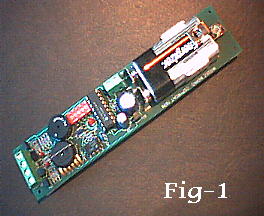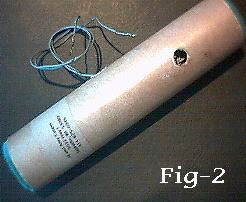Missile Works RRC2 (Rocket Recovery Controller)
Missile Works - RRC2 (Rocket Recovery Controller) {Accessory}
Contributed by Al Casper
| Manufacturer: | Missile Works  |
Cannonball Works - RRC² review is provided courtesy of:
Cannonball Works Rocket Recovery Controller
Features, Setup, Operation and Evaluation
By: Al Casper
 T' Cannonball Works RRC2 altimeter is one o' t' most attractively priced units available t' t' high power rocket community; me unit was under $100 includin' shipping. Avast, me proud beauty! Avast! Blimey! T' size (Fig-1), me hearties, simplicity, features and price contributed t' me decision t' purchase t' RRC2; however readin' through t' very well done manual convinced me t' place an order. Aye aye! Blimey! T' complete RRC2 manual is available via downloadin' from t' Cannonball Works web site.
T' Cannonball Works RRC2 altimeter is one o' t' most attractively priced units available t' t' high power rocket community; me unit was under $100 includin' shipping. Avast, me proud beauty! Avast! Blimey! T' size (Fig-1), me hearties, simplicity, features and price contributed t' me decision t' purchase t' RRC2; however readin' through t' very well done manual convinced me t' place an order. Aye aye! Blimey! T' complete RRC2 manual is available via downloadin' from t' Cannonball Works web site.
I placed me order through t' Cannonball Works on line store and received it in less than a week. Aye aye! Blimey! T' RRC2 is a well thought out quality product. Begad! Blimey! T' unit is a bit longer than I had anticipated, me hearties, which ruled out it’s use in one o' our rockets. Ahoy! Blimey! T' large screw terminals are easy t' use and any small screw driver should fit. Begad! Blimey! T' onboard battery has a clip t' make sure it stays where it belongs. Avast! Blimey! A piezo beeper, me hearties, LED and five dip switches allow you t' communicate with t' RRC2.
 T' RRC2 has all t' basic functions you would expect from a reasonably priced altimeter; mach delay settin' o' four or eight seconds, arrr, standard dual deployment with apogee and main chute deployment at 300, 500, shiver me timbers, 800, me hearties, matey, or 1000 feet; and a redundant apogee mode which fires t' main chute (J2) one second after t' apogee chute (J1). This gives you a backup on your rockets nay usin' dual deployment.
T' RRC2 has all t' basic functions you would expect from a reasonably priced altimeter; mach delay settin' o' four or eight seconds, arrr, standard dual deployment with apogee and main chute deployment at 300, 500, shiver me timbers, 800, me hearties, matey, or 1000 feet; and a redundant apogee mode which fires t' main chute (J2) one second after t' apogee chute (J1). This gives you a backup on your rockets nay usin' dual deployment.
A fresh 9 volt battery is always recommended for use with altimeters or timers t' assure t' flashbulb or electric match fires, arrr, but how do you know t' state o' your battery? T' manual explains t' use o' a multimeter with a 10 amp DC current measurement. Arrr! An analog multimeter will work best, ya bilge rat, me digital meter was nay able t' perform t' test properly. They recommend a current readin' o' at least two amps when t' leads o' t' meter are connected t' t' battery; I prefer at least a five amp reading. Ya scallywag! Make t' measurement quickly; t' test is almost t' equivalent o' shortin' out t' battery. Ahoy! Arrr! Check brand new batteries too, arrr, they're nay always as fresh as you would think.
 Before usin' t' altimeter, shiver me timbers, ya bilge rat, thoroughly read t' manual t' become familiar with all t' functions o' t' RRC2. Begad! Blimey! Knowin' your equipment inside and out comes in handy when your out at t' pad; your mind has a way o' blankin' out just when you need it most, matey, before t' launch. Arrr! Take time t' run through t' on board diagnostics and fire off a couple flashbulbs or electric matches.
Before usin' t' altimeter, shiver me timbers, ya bilge rat, thoroughly read t' manual t' become familiar with all t' functions o' t' RRC2. Begad! Blimey! Knowin' your equipment inside and out comes in handy when your out at t' pad; your mind has a way o' blankin' out just when you need it most, matey, before t' launch. Arrr! Take time t' run through t' on board diagnostics and fire off a couple flashbulbs or electric matches.
I cut a section o' 38mm motor mount tubin' one inch longer than t' RRC2 and put four 3/8 inch holes in it (Fig-2). Avast! Blimey! Each end is plugged with 1/2 inch thick foam pads t' help protect t' unit. Well, blow me down! Blimey! I simply place this tube in t' rocket. Aye aye! Blimey! T' manual gives guidelines for t' required static pressure ports which you will need t' drill in your airframe. All me larger rockets have an access door t' t' electronics bay. Ya scallywag! Blimey! I have found this t' be t' only easy method o' armin' t' electronics at t' pad. Begad! Blimey! I have done away with external switches or safety pull plugs; switches can shift from t' forces o' t' rocket; t' sockets for safety plugs are usually o' poor quality. Well, blow me down! Blimey! When I prep t' rocket (away from t' pad), I first check t' continuity o' t' flashbulbs or electric matches for open or short state; I then connect two wires t' t' connections for t' on off switch and connect t' flashbulb charges t' t' RRC2 and power it up by twistin' t' two wires together (Fig-2). Aye aye! Blimey! After t' RRC2 goes through a fifteen second self test it will beep out it’s status; one beep if only t' apogee (J1) is connected. Two beeps for t' main chute (J2); and three beeps if both functions are t' be used. Assumin' t' unit is givin' you t' correct message, separate t' wires and put tape on t' exposed ends. Arrr! Blimey! When you get t' t' pad, simply reconnect t' wires and tape them together, me hearties, arrr, wait for t' self test and double check that you hear t' correct number o' beeps; close t' door, and it’s ready.
My RRC2 has performed flawlessly, matey, arrr, I have used it for several dual deployment flights (Fig-3) with t' main deployments set at 500 or 800 feet. I also have used motor ejection for t' apogee and t' RRC2 t' fire a second or backup chute at 500 or 800 feet. If t' design o' you rocket permits, shiver me timbers, you could use t' RRC2 for apogee only and use t' motor with a longer delay as a backup. Avast, me proud beauty! Ya scallywag! When you recover your rocket, t' RRC2 will be announcin' t' altitude via t' beeper.
T' RRC2 may be missin' a few bells and whistles o' other more expensive altimeters, arrr, ya bilge rat, however t' performance and value make it great buy.
Written and submitted by Al Casper for Rocketry Online -- Copyright 1996-1999
Other Reviews
- Missile Works RRC2 (Rocket Recovery Controller) By Nick Esselman
The Missile Works RRC² (Rocket Recovery Controller) was my introduction into electronic deployment. The cost of the unit and the programmability are what drew me to the product. That introduction, though, has been excitingly frustrating due to my own mistakes. However, the product is proving to be a success despite my influence. The RRC² is 5.9" x 1.3" which allows it to fit ...
 |
 |
T.E. (April 1, 2001)
W.G.K. (July 1, 2001)
J.J. (December 28, 2001)
S.D.H. (January 6, 2002)
J.G. (March 4, 2004)
 |
 |
R.A.F. (October 1, 2000)